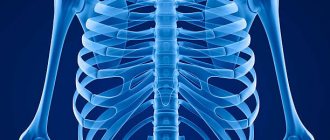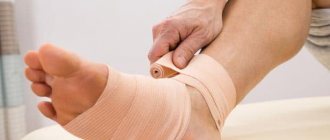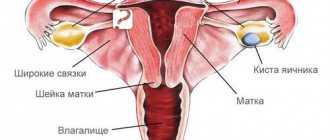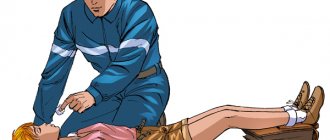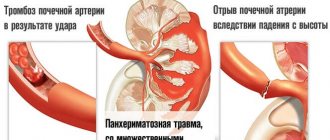According to statistics, in recent years, neck pain has begun to bother people more often. This was facilitated by the emergence of computers and new “sedentary” professions. Today, many people do not exercise, are overweight, and often experience stress - these factors also play a role in the occurrence of neck pain. What exactly causes neck pain and how to deal with it?
Cervical radiculitis (“pinched nerve”)
Radiculitis at the level of the cervical spine most often occurs when the roots of the spinal nerves are compressed.
This usually occurs due to cervical spondylosis or a herniated disc, where the outer portion of the disc (the annulus fibrosus) ruptures and the nucleus pulposus of the disc protrudes into the spinal canal. Sometimes cervical sciatica occurs due to infections (herpes virus infection, Lyme disease).
How does it manifest itself? Often there is pain in the neck, radiating to the arm. Moreover, the hand may become numb or weaken. Typically, the diagnosis of cervical radiculitis can be made after a neurological examination. However, in some cases it may be necessary to perform a computed tomography or electromyography scan.
Prevention
Preventive measures aimed at eliminating spasms of the cervical muscles include the following:
- daily exercises to strengthen the muscles of the cervical spine;
- preventive massage course once every six months;
- annual medical examination;
- complete rest;
- balanced diet;
- consumption of at least two liters of water per day;
- rejection of bad habits;
- active lifestyle.
Make an appointment through the application or by calling +7 +7 We work every day:
- Monday—Friday: 8.00—20.00
- Saturday: 8.00–18.00
- Sunday is a day off
The nearest metro and MCC stations to the clinic:
- Highway of Enthusiasts or Perovo
- Partisan
- Enthusiast Highway
Driving directions
Diffuse skeletal hyperostosis (Forestier disease)
This disease develops mainly in people over 50 years of age. It has been established that the most likely cause of the development of Forestier disease is the accumulation of calcium salts in the ligamentous apparatus of the spine.
Forestier's disease may not manifest itself in any way, but in some cases a person's neck mobility decreases and pain occurs. To confirm the diagnosis, the doctor will prescribe an X-ray examination, and in some cases, a computed tomography or magnetic resonance imaging scan will be required. There is no specific treatment for this disease.
Diagnostics
First of all, you should contact a therapist and describe the disturbing symptoms. The doctor will immediately be able to:
- measure blood pressure, because such complaints may be the cause of the onset of a hypertensive crisis;
- determine the pulse rate and decide to take an electrocardiogram to exclude cardiac arrhythmias;
- palpate paravertebral points and spinous processes, identifying painful sensations in the spine.
If pressure and heart rate are within normal limits, and changes are detected in the spine, further diagnostic measures are necessary and consultation with a neurologist is necessary.
In the absence of signs of cardiovascular disorders, to accurately determine the causes of a headache in the back of the head and select effective remedies to eliminate it, you need to consult a neurologist. A doctor’s appointment includes clarification of the complaint, collection of a history of the development of the disease, as well as clarification of the presence of a hereditary predisposition to certain disorders. At the first consultation, the neurologist will set the level of pain on a visual analogue scale (VAS), check pain points in the paravertebral areas and along the peripheral nerve trunks. A detailed neurological examination is also required, during which the following is assessed:
- patient position;
- level of consciousness;
- presence of signs of injury;
- breathing rhythm;
- eye movement and pupil size;
- muscle tone of the face, tongue, pharynx;
- hearing level;
- stiff neck;
- the amount of muscle tone on both sides of the body;
- presence of limited active and passive movements;
- tendon reflexes;
- coordination of movements;
- presence of sensory disturbances.
The examination will allow us to make a preliminary diagnosis and prescribe those research methods that will most help establish the final diagnosis and prescribe treatment.
Despite the fact that the main cause of headaches in the back of the head is diseases of the spine, changes in the brain itself cannot be ruled out. Therefore, electroencephalography (EEG) and even MRI of the brain are sometimes indicated.
X-ray of the cervical spine
X-ray of the cervical spine is a routine diagnostic procedure and does not require a long time. As a rule, the study itself lasts no more than 3-5 minutes.
X-rays of the cervical spine are taken in an upright position with the patient sitting or standing. This is necessary to obtain images under natural physiological stress.
A functional x-ray examination of the spine is often indicated. It allows you to register disturbances in the motor function of intervertebral discs at earlier stages of pathological processes, and to identify forward or backward displacement of the vertebrae. The essence of the study is to take radiographs of the cervical spine with maximum lateral tilt in the direct projection or maximum flexion and extension in the lateral projection.
Displacement of the vertebrae indicates a loss of the fixation ability of the disc, that is, the initial manifestations of osteochondrosis.
MRI
MRI diagnostics are carried out in specially organized rooms. No special preparation is required to carry it out. However, the research procedure itself will take more time than, for example, x-ray diagnostics. To do this, you will need to set aside about an hour in your schedule.
This study has become widespread due to its high information content and the possibility of making a diagnosis in the early stages of the disease. When examining the cervical spine, it is possible to assess the condition of the cervical vertebrae, intervertebral discs, adjacent soft tissues, nerves, blood vessels and the spinal cord. The area of study can be examined down to a millimeter, which helps identify pathology in the early stages. The changes revealed by this diagnostic method coincide with the X-ray ones: a decrease in the height of the vertebra and intervertebral foramina, changes in the intervertebral discs, protrusion and hernia.
Ultrasound of head and neck vessels
Ultrasound of the vessels of the head and neck is a common diagnostic method that does not require special preparation. It takes about 20 minutes and the result is given by the ultrasound doctor immediately after the procedure.
The method allows you to assess the condition of the inner wall of the vessel, the speed of blood flow and makes it possible to conduct functional tests. Most often it is used to identify developmental anomalies, the presence of atherosclerotic plaques leading to narrowing of their lumen, the presence of external compression, including intervertebral hernias or deformed vertebrae. Ultrasound results complement MRI.
Degenerative diseases
Discogenic pain syndrome is perhaps the most common cause of neck pain. The syndrome develops due to degenerative changes in the structure of the intervertebral discs. As a result, the load is distributed unevenly between the discs, facet joints, and endplates. With this disease, pain in the neck occurs when turning or tilting the head; the condition worsens if you keep your head in one position for a long time. This pain may be referred to the arm or shoulder.
Cervical spondylosis occurs due to degenerative changes in the cervical spine. Gradual wear of the intervertebral discs leads to a reduction in the intervertebral space, deformation of the bones and their proliferation (formation of osteophytes). In most cases, these age-related changes do not cause any inconvenience. However, they sometimes result in pressure on the spinal nerve root, causing chronic neck pain and, in some cases, numbness or pain in the shoulder or arm.
Spondylogenic cervical myelopathy. Degenerative changes in the cervical spine can lead to a narrowing of the central canal of the spinal cord, which can cause the spinal cord itself to become damaged and begin to malfunction. As a result, neck pain, limited mobility, as well as general weakness, poor coordination of movements, uncontrolled urination and defecation, and problems in the sexual sphere. The disease most often develops after 55 years of age and often requires surgical intervention.
Treatment for neck pain
For each patient, treatment tactics are developed strictly individually based on the diagnosis, the severity of pathological changes, the presence of concomitant diseases and other factors. Even patients with the same disorders may be prescribed different treatments, since even age and level of physical development influence it.
Nevertheless, the treatment of diseases that cause neck pain is always complex and includes both symptomatic and etiotropic therapy. In other words, it is aimed at eliminating both the symptoms of the disease and the causes of its occurrence. The main components of therapy are often:
- drug treatment;
- osteopathy;
- manual therapy;
- massage;
- physiotherapy (phonophoresis, carboxytherapy, ozone therapy, RF current pressure therapy);
- individual sessions with a rehabilitation specialist.
When diagnosing pathologies of the cervical spine, it is recommended to make some adjustments to your lifestyle and habits. Thus, office workers, drivers, seamstresses and representatives of other sedentary professions are recommended to stretch as often as possible and avoid long-term forced body positions, especially ones that require tension in the neck muscles.
It is also important to eat properly so that the body receives all the substances it needs. This will not only slow down the progression of pathology, but will also contribute to faster regeneration processes.
In case of severe pain, the chiropractor may recommend that the patient purchase a neck brace or Chance collar. Wearing it will help relieve the load on the cervical spine and avoid making thoughtless sudden movements, which will lead to a gradual fading of the pain syndrome. In our center you can select and purchase a bandage that suits you
Before visiting a doctor, in order to reduce pain, you can wrap your neck with a woolen scarf or take a painkiller tablet no later than 12 hours before your appointment.
Drug therapy
The nature of the prescribed drugs and their quantity can vary within very wide limits, which directly depends on the diagnosis and the presence of concomitant diseases. Therefore, we list only those groups of drugs that are prescribed to the vast majority of patients:
- NSAIDs are nonsteroidal anti-inflammatory drugs that also have analgesic properties (produced in various dosage forms, including tablets, ointments, injection solutions, etc.);
- corticosteroids are drugs with a powerful anti-inflammatory effect, which are used only in cases of severe inflammatory processes that cannot be eliminated by NSAIDs;
- muscle relaxants - medications that eliminate muscle spasms of various origins, which helps reduce the severity of pain;
- chondroprotectors are drugs that promote the restoration of the cartilage tissue that makes up the intervertebral discs, but are effective only in the initial stages of the development of osteochondrosis. To prevent diseases of the musculoskeletal system, we recommend to our patients the most effective drug Mermaids Marine Collagen;
- B vitamins - are used to improve the conductivity of bioelectric impulses from the spinal cord to the corresponding organs and restore their proper functioning;
- Vitamin D is a remedy responsible for the condition of bone tissue, as well as for higher brain functions, such as memory, memory, attention, and speech.
Patients may also be prescribed antibiotics, hormone replacement therapy, antihypertensive drugs, and others.
For particularly severe pain in the neck, blockades are used. The procedures involve the injection of anesthetic solutions with corticosteroids into the area where the nerves pass in the neck, which allows for very quick pain relief. But, in addition to the fact that they are effective only for pain caused by nerve damage, they require a high level of professionalism from medical workers, since when performing a blockade there is a risk of injuring the nerve, causing infection and causing serious complications.
Manual therapy
Manual therapy is one of the most effective ways to combat neck pain and the causes of its occurrence, but only if carried out correctly. It involves a direct impact on the spine and surrounding soft tissues. Do not confuse manual therapy with therapeutic massage, which only works the muscles of the back and neck.
Techniques and methods of manual therapy allow literally after the first session to achieve a significant improvement in well-being, and ultimately complete remission. This is achieved through:
- restoration of the normal axis of the spine by returning the vertebrae to their anatomically correct position;
- increasing the distance between the vertebral bodies and releasing compressed nerves and blood vessels, which helps eliminate signs of radicular syndrome, improve the functioning of internal organs and especially the brain;
- elimination of spasm of neck muscles and functional blocks, which improves mobility and reduces pain;
- improving blood circulation and tissue nutrition.
We do not have general standards of treatment; we apply an individual approach to each patient. You should trust manual therapy only to a highly qualified specialist. Otherwise, the use of inappropriate techniques can only harm the patient, aggravate the problem, or provoke the development of complications.
Physiotherapy
Physiotherapeutic procedures are used to increase the effectiveness of the therapy. They are indicated exclusively outside the acute period and have an analgesic, anti-inflammatory effect, and also improve microcirculation in soft tissues and help normalize muscle tone.
Typically, courses consisting of 8-15 procedures are prescribed. It can be:
- electrophoresis;
- UHF;
- ultrasound therapy;
- laser therapy;
- traction therapy (spinal traction);
- mud baths, etc.
The number of sessions of physiotherapeutic procedures and the frequency of their implementation are selected by the doctor individually. Some procedures can be combined with each other, while others should be performed strictly at a certain interval.
Exercise therapy
Physical therapy is one of the mandatory components of conservative therapy for neck pain. Since very often they occur against the background of muscle overstrain and the resulting degenerative-dystrophic processes in the intervertebral discs, it is important to pay due attention to exercise therapy and practice daily.
For each patient, a physical therapy program is developed separately by a rehabilitation physician. Using complexes presented on the Internet can be dangerous, since they do not take into account the individual characteristics of the patient, his age, the degree of neglect of the pathological process and the level of physical fitness of the patient. Therefore, to develop a physical therapy program, the help of a specialist is required. Moreover, the first few classes must be carried out under his supervision, so that the patient can understand how to perform each exercise and does not harm himself in the process of independent training. You should exercise at home in a calm environment, avoiding any sudden movements, and if pain occurs, you should consult a doctor.
Thus, neck pain is a widespread phenomenon. They can be caused by the development of various diseases, but most often the cause of discomfort is problems with the spine caused by a sedentary lifestyle. Therefore, you should not hesitate to consult a doctor. Indeed, in the early stages of the development of the disease, it can be easily dealt with using conservative methods. While in advanced cases, neck pain and the causes that cause them can be eliminated exclusively through surgery.
5 1 vote
Article rating
Muscle pain
Spasms of the muscles of the neck and upper back occur due to injuries, physical strain during the day, in particular, incorrect postures, and emotional stress. Also, muscles can spasm due to an uncomfortable pillow. This condition usually manifests itself as pain and limited neck mobility. Within 6 weeks the pain goes away. To speed up the process, it is recommended to do special exercises, as well as eliminate the cause of muscle strain, if possible.
Shoulder joint, its structure and functions
The shoulder joint is a complex joint, representing the articulation of the humerus and scapula. It connects the upper limb and the shoulder girdle. Its peculiarity is its great mobility, due to which the limbs can perform movements with a wide amplitude and in different directions. Anatomically, this is due to the absence of real ligaments, and instead, the supporting function is performed by the shoulder muscles. The structure of the shoulder joint allows the following movements of the upper limb:
- flexion and extension relative to the vertical axis;
- abduction and adduction of the upper limb to the body;
- supination and pronation - outward and inward movements;
- circular, rotational movements.
The shoulder joint is multiaxial, spherical. Its main function is to provide a wide range of movements of the upper limbs, which is necessary for everyday activities. The lack of rigid adhesion of bone elements through ligaments leads to a high risk of dislocations and sprains. These injuries require long-term recovery and can cause chronic headaches.
Cervical osteochondrosis?
Among the diseases that cause neck pain, we did not mention “cervical osteochondrosis.” This diagnosis is usually made in the countries of the former Soviet Union. In fact, all the diseases listed above are attributed to osteochondrosis.
Degenerative changes in the spine are observed in almost all people over 40 years of age, and this is absolutely no reason to call a person sick and begin active treatment. Neck pain and other symptoms should indicate a real diagnosis, after which therapy is prescribed.
When should you see a doctor for neck pain?
The main reasons for which a consultation with a neurologist is necessary:
- Strong headache;
- neck injury;
- loss of control over urination or bowel movements;
- numbness, tingling, weakness in the arms or legs;
- the pain does not go away for a week, and there is no improvement;
- when conventional painkillers do not help.
See your doctor immediately if:
- You have a fever, a headache, and your neck is so stiff that you cannot reach your chin to your chest. It could be meningitis;
- Signs of a heart attack include chest pain, rapid breathing, sweating, nausea, vomiting, and pain in the arm or jaw.
Reviews of doctors providing the service - Cervical lumbago
In 2000, Andrei Arkadyevich performed spinal surgery on me.
Four days in the clinic and I have been living a full life for 20 years without restrictions on movement and I remember with gratitude Dr. A.A. Khodnevich. God bless him. And in 2000 he could walk no more than 10 meters. Read full review Viktor Alexandrovich
20.05.2020
Low bow to Alexander Semenovich Bronstein and Andrei Arkadyevich Khodnevich. I arrived at CELT on July 2, 2021 with extreme pain that I endured for 10 days. Hernia C6-C-7. I was given two blockades in Ivanovo, about 9 complex IVs, I lost 6 kg in a week and was in a panic, I didn’t see a way out and nothing happened to me... Read full review
Elena Nikolaevna L.
20.10.2019
Therapy methods
Typically, patients diagnosed with cervical intervertebral hernia suffer from the pathology for more than one year, and exacerbations and remissions are regularly observed. Often, painful sensations weaken over time or disappear on their own a couple of weeks after a subsequent exacerbation.
Conservative methods of therapy will not help to completely get rid of the problem; it helps to cope with the consequences of the hernia’s impact on the soft tissue, muscles and nerve endings. Often, as a residual phenomenon, the presence of a vegetative reflex effect on the tone of vascular tissue - neurovascular symptoms - is observed.
Complex therapy involves taking the following pharmaceuticals:
- non-steroidal anti-inflammatory drugs (COX-2 inhibitors);
- muscle relaxants with central action;
- As auxiliary methods, medicinal electrophoresis using vitamins and aminophylline is prescribed.
When the exacerbation subsides, the use of physiotherapeutic procedures is indicated. To activate blood circulation in muscle tissue, it is recommended to perform physical therapy and massage of the cervical-collar region (movements must be extremely careful).
Treatment of cervical intervertebral hernia with relatively crude methods, such as manual therapy, traction, can cause a significant aggravation of the condition. This will lead to the development of serious negative consequences.
As an emergency measure, it is recommended to wear a Shants collar if pain occurs. The device is used to support the head and helps prevent sudden bending and turning of the head, which can lead to the development of compression symptoms and sometimes fainting.
After the collar is applied, it is better to immediately consult a neurologist and have an MRI of the neck performed; then you may need to consult with a neurosurgeon. This will help to assess the possible risk for a similar location of the pathology and determine the choice of treatment regimen.
What will prevent cervicalgia
Simple rules for preventing a situation where the head cannot turn and the neck hurts are as follows:
- if you work at a computer, place the monitor so that its center is located slightly below eye level, and your body and head are in the same plane when working (so that you don’t have to constantly turn or tilt your head);
- the mouse should be positioned so that you don’t have to reach for it or strain your hand while working;
- You should not carry a load on one shoulder, even if it seems insignificant: in order to prevent the belt from slipping, a person reflexively raises the shoulder with the bag, overstraining the muscles in an anatomically incorrect position;
- after physical activity, when the muscles are warm, avoid drafts;
- choose a mattress and pillows so that your neck is in the anatomically correct position during sleep;
- Do warm-up exercises for your neck and back during the workday.
These measures will prevent one-sided, anatomically incorrect load on the cervical spine, which impairs blood circulation. The quality of sleep will improve, fatigue will decrease, and performance will increase. If, despite all the efforts made, your neck periodically hurts and turning it hurts , only a doctor will tell you what to do .
MBST therapy
This modern technique is used for joint pathologies to restore cartilage tissue and discs. The treatment mechanism is based on high-pulse magnetic resonance at the cellular level.
The procedure promotes:
- increasing the volume of cartilage tissue due to cell restoration;
- increased cartilage density due to increased collagen levels;
- relieving pain.
You can treat a hernia of the cervical spine in Moscow at ArthroMedCenter. MBST therapy will help eliminate pain and spasm, as well as the underlying causes of the disease.
